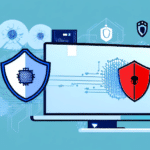Can Hackers Shut Down an Ecommerce Business? Here's What You Need to Know
In today's digital age, cybersecurity has become a critical issue for businesses of all sizes, including ecommerce enterprises. As consumers continue to flock to online shopping, the risks of cyber attacks on ecommerce businesses have increased significantly. In this article, we will explore the threat landscape for ecommerce businesses, the financial and reputational costs of a hack attack, common tactics used by hackers, how to identify vulnerabilities in your ecommerce business's security infrastructure, best practices for securing your ecommerce site against hackers, the importance of regularly updating your security protocols, response strategies for dealing with a cyber-attack, how to build a crisis management plan, collaborating with industry experts, why employee education is key to preventing cybersecurity incidents, and finally, case studies of how other ecommerce businesses have responded and recovered from cyber attacks.
Understanding the Threat Landscape for Ecommerce Businesses
The threat landscape for ecommerce businesses is constantly evolving, as hackers become increasingly sophisticated in their methods and tactics. Ecommerce businesses are particularly vulnerable to cyber attacks due to the large amounts of sensitive customer data they handle daily, including names, addresses, credit card details, and purchase histories. Moreover, ecommerce businesses are often targeted by hackers due to the high financial rewards they offer if the attack is successful. According to the 2023 Cybersecurity Threat Landscape report, approximately 43% of cyber attacks are targeted towards small businesses, with ecommerce businesses being among the most at-risk.
One of the most common types of cyber attacks that ecommerce businesses face is phishing. Phishing attacks involve sending fraudulent emails or messages that appear to be from a legitimate source, such as a bank or ecommerce website, in order to trick users into providing sensitive information. These attacks can be difficult to detect, as they often use convincing logos and language to appear legitimate. Ecommerce businesses can protect themselves from phishing attacks by:
- Implementing strong email security protocols
- Training employees to recognize phishing attempts
- Regularly updating their security software
The Financial and Reputational Costs of a Hack Attack on Your Ecommerce Business
The financial and reputational costs of a hack attack on your ecommerce business can be significant. The direct costs of a cyber attack can include loss of revenue, cost of repairing damaged systems, and the cost of notifying customers and other stakeholders. According to the IBM Cost of a Data Breach Report 2023, the average cost of a data breach in the ecommerce sector is approximately $4.24 million.
In addition, a cyber attack can have long-term effects on your brand reputation, customer trust and loyalty, and competitive position in the market. The indirect costs of a cyber attack can continue for years, as customers and other stakeholders may lose confidence in your ability to protect their personal and financial information.
One of the most significant indirect costs of a cyber attack is the potential for legal action. If customer data is compromised, you may face lawsuits and regulatory fines. For instance, under the General Data Protection Regulation (GDPR), fines can reach up to €20 million or 4% of your annual global turnover, whichever is higher. These costs can be substantial and can further damage your brand reputation. It is essential to have a plan in place to address any legal issues that may arise in the event of a cyber attack.
Another indirect cost of a cyber attack is the loss of productivity. A successful attack can disrupt your business operations, leading to downtime and lost productivity. This can result in missed deadlines, delayed projects, and lost revenue. It is crucial to have a disaster recovery plan in place to minimize the impact of a cyber attack on your business operations.
Common Tactics Used by Hackers to Shut Down Ecommerce Sites
Hackers use a wide variety of tactics to shut down ecommerce sites, including:
- Distributed Denial of Service (DDoS) attacks: Involves flooding a site with large amounts of traffic, overloading the server and causing it to crash.
- Malware attacks: Involves infecting a website with malicious software that can steal sensitive information, hijack user sessions, and damage system files.
- Phishing attacks: Tricks users into sharing sensitive information, such as login credentials or credit card information, by posing as a legitimate entity.
- Social engineering attacks: Manipulates users into divulging sensitive information by exploiting their natural human tendencies, such as curiosity, fear, or greed.
- Ransomware attacks: Encrypts a website's files and demands payment in exchange for the decryption key. If the website owner refuses to pay, the hacker may threaten to delete the encrypted files or leak sensitive information.
Ransomware attacks can be particularly devastating for ecommerce sites, resulting in the loss of customer data, revenue, and reputation. Ecommerce sites can prevent ransomware attacks by implementing strong security measures such as regular backups, software updates, and employee training on how to identify and avoid phishing emails.
How to Identify Vulnerabilities in Your Ecommerce Business's Security Infrastructure
The first step in securing your ecommerce business against cyber attacks is to identify vulnerabilities in your security infrastructure. This can be achieved through:
- Regular security assessments: Conducting comprehensive evaluations of your security measures to identify potential weaknesses.
- Penetration testing: Simulating a cyber attack to identify potential vulnerabilities in your systems and processes.
- Regularly reviewing and updating security policies: Ensuring that your security policies and procedures are current and effective.
- Employee training: Educating your staff on best practices for maintaining security.
- Implementing security technologies: Utilizing firewalls, anti-virus software, and intrusion detection systems to protect your infrastructure.
Staying up-to-date with the latest security threats and trends is also crucial. Subscribe to security newsletters, attend security conferences and webinars, and network with other security professionals. By staying informed, you can proactively identify potential threats and take steps to mitigate them before they become a problem.
Best Practices for Securing Your Ecommerce Site Against Hackers
Implementing best practices is essential for securing your ecommerce site against hackers. Key practices include:
- Regularly updating software and systems: Ensure that your operating system, web server, and ecommerce platform are up-to-date to resolve known vulnerabilities.
- Strong password policies: Enforce the use of complex passwords and encourage regular password changes.
- Two-factor authentication (2FA): Adds an extra layer of security by requiring two forms of identification before granting access.
- Encryption technologies: Protect sensitive data by encrypting information both in transit and at rest.
- Securing network and infrastructure: Utilize firewalls, intrusion detection systems, and other enterprise-class security solutions to protect your network.
Implementing these practices can significantly reduce the risk of cyber attacks and safeguard your ecommerce business from potential threats.
The Importance of Regularly Updating Your Ecommerce Business's Security Protocols
Effective cybersecurity is an ongoing process that requires regular monitoring, updates, and reviews. This is especially important for ecommerce businesses, which are at a higher risk of cyber attacks due to the sensitive and valuable data they handle. Regularly updating your security protocols involves:
- Continuously assessing and improving your security infrastructure
- Monitoring emerging threats and vulnerabilities
- Implementing the latest security technologies
- Ensuring compliance with industry standards and regulations such as PCI DSS
By maintaining up-to-date security protocols, you can ensure that your ecommerce business remains protected against the latest threats and meets all necessary compliance requirements.
Response Strategies for Dealing with a Cyber-Attack on Your Ecommerce Site
The best response to a cyber attack on your ecommerce site is a proactive one. Key strategies include:
- Incident response plan: Develop a robust plan that includes clear steps for responding to a security incident, communication protocols, and a clear chain of command.
- Experienced response team: Assemble a team of IT specialists, legal counsel, and public relations experts who can quickly and effectively respond to incidents.
- Immediate notification: Notify key stakeholders promptly when a security incident occurs.
- Damage containment and mitigation: Implement a plan to contain the breach and mitigate its impact on your business.
Having these strategies in place ensures a swift and effective response, minimizing the damage caused by cyber attacks.
How to Build a Crisis Management Plan for Your Ecommerce Business in Case of a Cyber-Attack
A crisis management plan is essential for ecommerce businesses to mitigate the impact of a cyber attack and protect your brand reputation. Key components of the plan include:
- Incident documentation: Keep detailed records of the incident, including how it was discovered, affected systems, and steps taken in response.
- Damage assessment: Evaluate the extent of the breach and its impact on your business operations and customer data.
- Stakeholder notification: Inform key stakeholders, including employees, customers, and partners, about the breach and the steps being taken to address it.
- Communication strategy: Develop a public relations strategy for responding to media inquiries and managing social media comments.
Establish clear lines of communication with both internal and external stakeholders to ensure a coordinated and effective response to any crisis.
Collaborating with Industry Experts to Protect Your Ecommerce Business from Cybercriminals
Collaborating with industry experts can significantly enhance your ecommerce business's cybersecurity posture. Strategies for collaboration include:
- Working with security vendors and consultants: Leverage their expertise to implement advanced security measures and conduct regular security audits.
- Joining industry organizations: Participate in groups that focus on sharing best practices and staying updated on emerging threats.
- Attending industry events: Engage in conferences and seminars to learn about the latest cybersecurity trends and technologies.
- Regulatory compliance: Stay informed about and comply with relevant regulations to avoid legal repercussions.
By collaborating with experts, you can access valuable resources and insights that help protect your ecommerce business from cybercriminals.
Why Employee Education is Key to Preventing Cybersecurity Incidents in Your Ecommerce Business
Employee education is a critical component of effective cybersecurity in ecommerce businesses. Key aspects of employee education include:
- Data security training: Educate employees on best practices for managing and protecting sensitive data.
- Phishing awareness: Train staff to identify and respond to phishing attempts and other social engineering tactics.
- Reporting protocols: Establish clear procedures for employees to report suspicious activities or potential security breaches.
- Policy enforcement: Implement and enforce policies regarding password management, data access, and device usage.
Regular training and awareness programs ensure that employees remain vigilant against cyber threats, significantly reducing the risk of cyber attacks and protecting your ecommerce business from financial and reputational harm.
Case Studies: How Other Ecommerce Businesses Have Responded to and Recovered from Cyber Attacks
Examining real-world case studies can provide valuable insights into the impact of cyber attacks on ecommerce businesses and the best practices for responding and recovering from incidents. For example:
- Target Data Breach (2013): The breach resulted in the compromise of 40 million credit and debit card details, costing the company an estimated $202 million in remediation costs. Target's response included mandatory password changes, establishing a call center for affected customers, and offering a 10% discount on all purchases to restore customer trust.
- eBay Data Breach (2014): This breach resulted in the loss of encrypted passwords and personal information for over 145 million customers. eBay's response involved resetting all passwords, offering customers credit monitoring services, and launching a bug bounty program to incentivize ethical hacking and proactively identify vulnerabilities.
These case studies highlight the importance of having a robust response plan, transparent communication, and proactive measures to recover from cyber attacks effectively.
Conclusion: Taking Action to Protect Your Ecommerce Business from Cybersecurity Threats
In conclusion, cybersecurity is a critical issue for ecommerce businesses and requires a proactive and ongoing approach to protect against the growing threats of cyber attacks. By understanding the threat landscape, identifying vulnerabilities, implementing best practices, regularly updating your security protocols, and having a robust incident response plan in place, you can significantly reduce the risk of cyber attacks and protect your business from financial and reputational harm. Investing in cybersecurity and collaborating with industry experts will help you stay ahead of the curve and safeguard your ecommerce business from the costly and damaging consequences of cyber attacks.




















